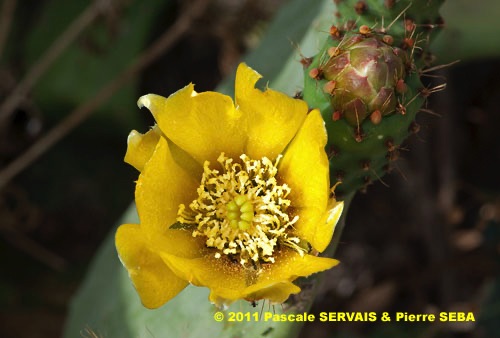
Opuntia ficus-indica (L.) Mill.
Fam. : Cactaceae
© Pascale SERVAIS & Pierre SEBA, 2018. Tilo Botanica: Flore de Tilos et du Dodécanèse / Flora of Tilos and of the Dodecanese
English translation by Brenda Bradbury, Howard Bradbury and Stéphane Léonard
Plante ligneuse, hermaphrodite, grasse, à tiges charnues formées d’articles aplatis qu’on pourrait prendre pour des feuilles et se lignifiant avec l’âge.
Feuilles non développées, réduites à de petits faisceaux d’aiguillons piquants.
Fleurs à symétrie radiaire, jaunes ou rougeâtres, de 5 à 6 cm de diamètre quand elles sont épanouies, isolées, sans pédoncule et placées sur le bord des articles supérieurs. Ovaire infère.
Fruits, baies charnues, ovoïdes ou en forme de figue, rougeâtre violacé, parfois jaunâtres, à faisceaux d’aiguillons très fins et très piquants.
___________________________
Plant woody, hermaphrodite, succulent. Stems fleshy, made of flattened articles that one could take for leaves and lignifying with age.
Leaves nondeveloped, reduced to small bundles of prickly prickles.
Flowers radially symmetrical, yellow or reddish, from 5 to 6 cm in diameter when opened out, isolated, without a peduncle and located on the edge of the higher articles. Ovary inferior.
Fruits, fleshy, ovoid or fig-shaped berries, purplish reddish, sometimes yellowish, with bundles of very thin and very prickly prickles.
Descripteurs / Identifying features
1
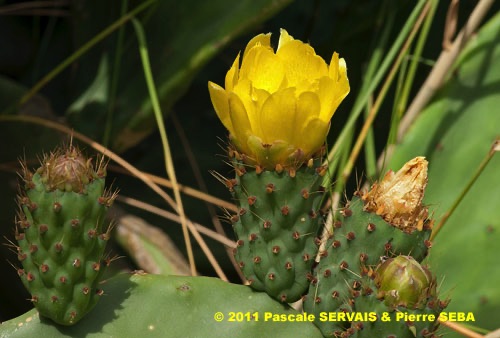
2
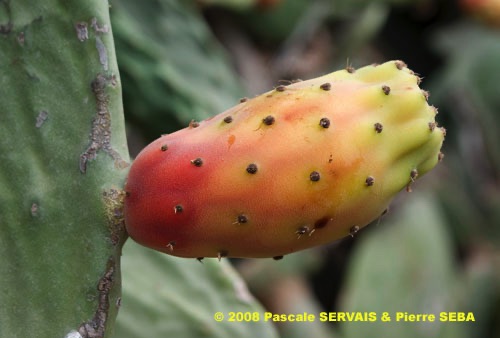
3
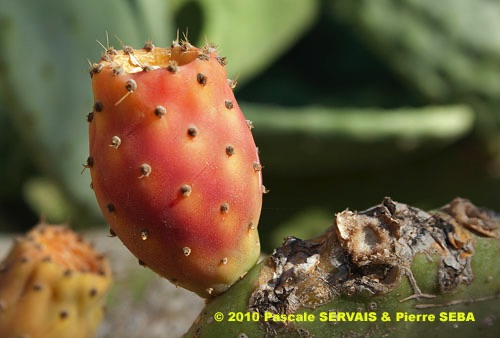
4
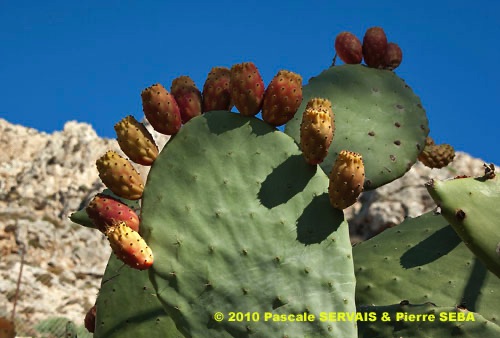
5
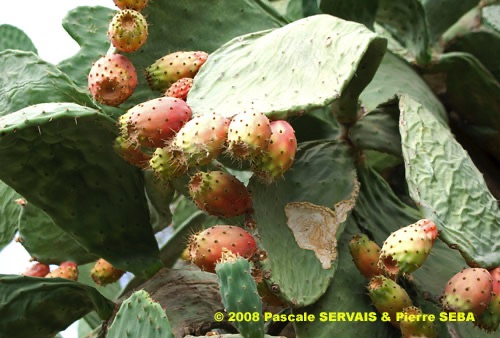
6
Étymologie / Etymology :
Opuntia : emprunt du latin Opus, -untis (nom propre) = Oponte
(capitale de la Locride, en Grèce), emprunt du grec ancien
Ὀποῦς, -οῦντος (nom propre) = Oponte, en référence à cette région
où poussaient différentes espèces de cactus.
Ficus-Indica : nom composé créé par les botanistes
[ < ficus, -i / -us (nom) = le figuier + indicus, -a, -um (adj.) = indien ]
= le figuier d’Inde.
Opuntia : borrowed from Latin Opus, -untis (proper noun) = Opus
(or Opous, capital of Locris, in Greece), borrowed from Classical Greek
Ὀποῦς, -οῦντος (proper noun) = Opus, referring to this region
where various species of cactus grew.
Ficus-Indica : compound name created by botanists
[ < ficus, -i / -us (noun) = fig tree + indicus, -a, -um (adj) = Indian ]
= Indian fig.
Synonymes / Synonyms :
Opuntia compressa McBride
Opuntia vulgaris Mill.
Cactus compressus Salisb.
Cactus ficus-indica L.
Cactus opuntia L.
Opuntia amyclaea Ten.
Opuntia ficus-barbarica A.Berger
Opuntia italica Ten. ex Pfeiff.
Noms vernaculaires / Common names :
Noms français / French names :
Chardon d’Inde — Figuier à raquettes — Figuier d’Inde —
Figuier de Barbarie — Nopal — Raquette.
Noms grecs / Greek names :
Οπουντία η ινδική συκή — Συκιά — Φραγκοσυκιά.
Noms anglais / English names :
Barbary fig — Indian fig — Indian pear — Mission cactus —
Mission prickly-pear — Prickly-pear —
Smooth mountain prickly-pear — Smooth prickly-pear —
Spineless cactus — Tuberous prickly-pear — Tuna — Tuna cactus.
Noms allemands / German names :
Echter Feigenkaktus — Feigenkaktus —
Gewöhnlicher Feigenkaktus — Indianische Feige — Kaktusfeige —
Stachelfeigen.
Noms espagnols / Spanish names :
Chumba — Chumbera — Higo chumbo — Higo de cactus — Higuera —
Nopal pelón — Palera — Tuna de España — Tunera — Tuno.
Noms italiens / Italian names :
Fico d’India — Fico d’India nano — Opunzia.
Habitat :
Lieux pierreux - Lieux incultes - Chemins - Haies, fourrés, broussailles.
Stony places - Waste ground - Waysides - Hedges, thickets.
Îles / Islands :
Patmos - Tilos.
Hauteur / Height range :
De 1 m à 5 m.
From 1 m to 5 m.
Floraison / Flowering time :
De mars à juillet.
From March to July.
Groupe / Classification :
Dicotylédones.
Dicotyledons.
Pérennité / Lifespan :
Vivace.
Perennial.
Description :
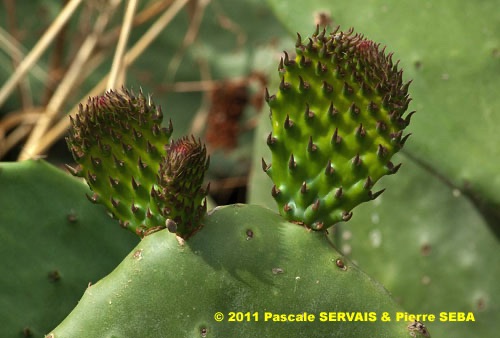
7
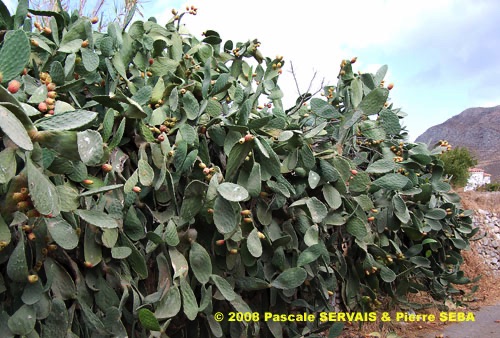
8
Photo 1 :
Localisation / Location : Tilos, Megalochorio, Environs
Date : 27/05/2011
GPS : Lat. 36,44971° N / Long. 27,34538° E / Alt. 21 m
Type : Photographie numérique / Digital Photograph (10 mégapixels)
Photo 2 :
Localisation / Location : Tilos, Megalochorio, Environs
Date : 27/05/2011
GPS : Lat. 36,44971° N / Long. 27,34538° E / Alt. 21 m
Type : Photographie numérique / Digital Photograph (10 mégapixels)
Photo 3 :
Localisation / Location : Tilos, Megalochorio, Environs
Date : 17/09/2008
GPS : Lat. 36,45326° N / Long. 27,34836° E / Alt. 52 m
Type : Photographie numérique / Digital Photograph (10 mégapixels)
Photo 4 :
Localisation / Location : Tilos, Megalochorio, Aghios Pandeleimonas
Date : 06/12/2010
GPS : Lat. 36,44803° N / Long. 27,30531° E / Alt. 269 m
Type : Photographie numérique / Digital Photograph (10 mégapixels)
Photo 5 :
Localisation / Location : Tilos, Megalochorio, Aghios Pandeleimonas
Date : 06/12/2010
GPS : Lat. 36,44803° N / Long. 27,30531° E / Alt. 269 m
Type : Photographie numérique / Digital Photograph (10 mégapixels)
Photo 6 :
Localisation / Location : Tilos, Megalochorio, Environs
Date : 17/09/2008
GPS : Lat. 36,45326° N / Long. 27,34836° E / Alt. 52 m
Type : Photographie numérique / Digital Photograph (10 mégapixels)
Photo 7 :
Localisation / Location : Tilos, Megalochorio, Environs
Date : 27/05/2011
GPS : Lat. 36,44971° N / Long. 27,34538° E / Alt. 21 m
Type : Photographie numérique / Digital Photograph (10 mégapixels)
Photo 8 :
Localisation / Location : Tilos, Megalochorio, Environs
Date : 17/09/2008
GPS : Lat. 36,45326° N / Long. 27,34836° E / Alt. 52 m
Type : Photographie numérique / Digital Photograph (10 mégapixels)

Google Maps
Google Maps
Google Maps
Google Maps
Google Maps
Google Maps
Google Maps
Google Maps